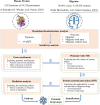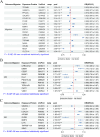Proteome-wide Mendelian randomization identified potential drug targets for migraine
- PMID: 39261750
- PMCID: PMC11389401
- DOI: 10.1186/s10194-024-01853-9
Proteome-wide Mendelian randomization identified potential drug targets for migraine
Abstract
Background: Migraine is a highly prevalent and complex neurovascular disease. However, the currently available therapeutic drugs often fall to adequately meet clinical needs due to limited effectiveness and numerous undesirable side effects. This study aims to identify putative novel targets for migraine treatment through proteome-wide Mendelian randomization (MR).
Methods: We utilized MR to estimate the causal effects of plasma proteins on migraine and its two subtypes, migraine with aura (MA) and without aura (MO). This analysis integrated plasma protein quantitative trait loci (pQTL) data with genome-wide association studies (GWAS) findings for these migraine phenotypes. Moreover, we conducted a phenome-wide MR assessment, enrichment analysis, protein-protein interaction networks construction, and mediation MR analysis to further validate the pharmaceutical potential of the identified protein targets.
Results: We identified 35 protein targets for migraine and its subtypes (p < 8.04 × 10-6), with prioritized targets showing minimal side effects. Phenome-wide MR identified novel protein targets-FCAR, UBE2L6, LATS1, PDCD1LG2, and MMP3-that have no major disease side effects and interacted with current acute migraine medication targets. Additionally, MMP3, PDCD1LG2, and HBQ1 interacted with current preventive migraine medication targets. The causal effects of plasma protein on migraine were partly mediated by plasma metabolites (proportion of mediation from 3.8% to 21.0%).
Conclusions: A set of potential protein targets for migraine and its subtypes were identified. These proteins showed rare side effects and were responsible for biological mechanisms involved in migraine pathogenesis, indicating priority for the development of migraine treatments.
Keywords: Drug targets; Mendelian randomization; Migraine; Proteomics.
© 2024. The Author(s).
Conflict of interest statement
The authors declare no competing interests.
Figures





Similar articles
-
Uncovering drug targets for cluster headache through proteome-wide Mendelian randomization analysis.J Headache Pain. 2025 Mar 20;26(1):57. doi: 10.1186/s10194-025-01999-0. J Headache Pain. 2025. PMID: 40114078 Free PMC article.
-
Genetic influence of the brain imaging phenotypes, brain and cerebrospinal fluid metabolites and brain genes on migraine subtypes: a Mendelian randomization and multi-omics study.J Headache Pain. 2025 May 20;26(1):124. doi: 10.1186/s10194-025-02063-7. J Headache Pain. 2025. PMID: 40394501 Free PMC article.
-
Association Between Hemostatic Profile and Migraine: A Mendelian Randomization Analysis.Neurology. 2021 May 18;96(20):e2481-e2487. doi: 10.1212/WNL.0000000000011931. Epub 2021 Apr 1. Neurology. 2021. PMID: 33795393 Free PMC article.
-
[Molecular genetics of migraine].Rev Neurol (Paris). 2005 Jul;161(6-7):651-3. doi: 10.1016/s0035-3787(05)85107-0. Rev Neurol (Paris). 2005. PMID: 16141949 Review. French.
-
The molecular pathogenesis of migraine: new developments and opportunities.Hum Mol Genet. 2013 Oct 15;22(R1):R39-44. doi: 10.1093/hmg/ddt364. Epub 2013 Aug 6. Hum Mol Genet. 2013. PMID: 23922230 Review.
Cited by
-
Atrophy of hypothalamic subregions increases migraine risk: cross-sectional study and mendelian randomization analysis.J Headache Pain. 2025 Aug 6;26(1):178. doi: 10.1186/s10194-025-02119-8. J Headache Pain. 2025. PMID: 40770287 Free PMC article.
-
Mediating Role of the ANGPTL3/TFPI Protein Ratio in Regulating T-Cell Surface Glycoprotein CD5 Levels on Knee Osteoarthritis (KOA): A Mendelian Randomization Study.Int J Mol Sci. 2025 May 8;26(10):4471. doi: 10.3390/ijms26104471. Int J Mol Sci. 2025. PMID: 40429617 Free PMC article.
-
Proteome-wide Mendelian randomization and functional studies uncover therapeutic targets for polycystic ovarian syndrome.Am J Hum Genet. 2024 Dec 5;111(12):2799-2813. doi: 10.1016/j.ajhg.2024.10.008. Epub 2024 Nov 13. Am J Hum Genet. 2024. PMID: 39541979 Free PMC article.
-
Uncovering drug targets for cluster headache through proteome-wide Mendelian randomization analysis.J Headache Pain. 2025 Mar 20;26(1):57. doi: 10.1186/s10194-025-01999-0. J Headache Pain. 2025. PMID: 40114078 Free PMC article.
References
-
- Lipton RB, Bigal ME (2005) The epidemiology of migraine. Am J Med 118(Suppl 1):3s–10s - PubMed
MeSH terms
Substances
LinkOut - more resources
Full Text Sources
Research Materials
Miscellaneous

